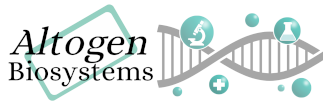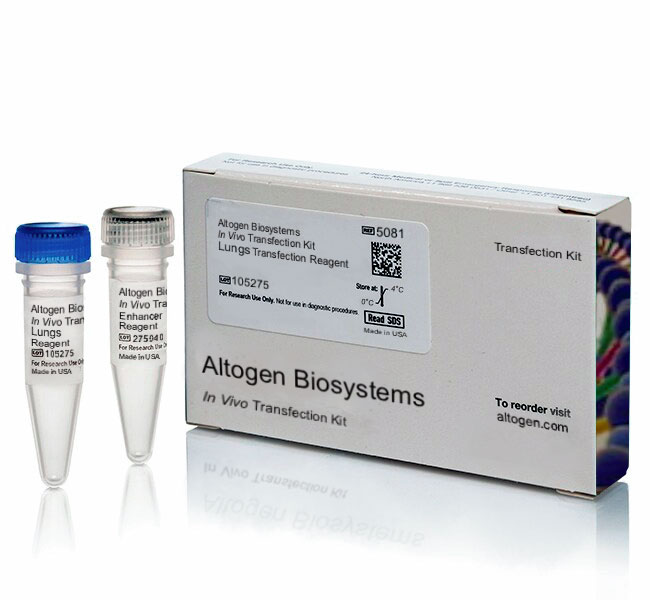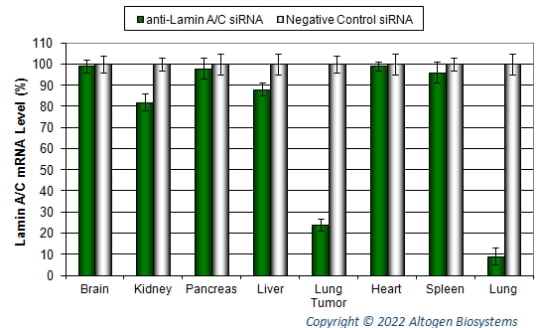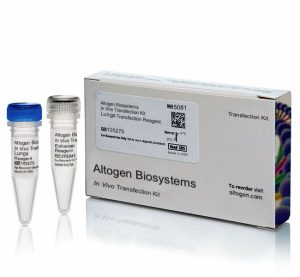Description
Purchase Orders: Click “Add to Cart” button to order, then email PO to orders@altogen.com.
Product Availability: In Stock.
Lungs-targeted In Vivo Transfection Reagent
Effectively delivers any negatively charged molecules (proteins, si/shRNA, mRNA, pDNA) into lungs. Transfection kit for animal laboratory research (mouse, rat)
Product Description:
Nanoparticle liposome-based reagent for intranasal or inhalation administration, efficiently delivers proteins, small molecules, RNA, and DNA to lung tissue and tumors in mice and rats without detectable cytotoxicity.
Lung-targeted In Vivo Transfection Kit
- Nanoparticle liposome-based reagent
- Intranasal or inhalation administration
- Efficient delivery of biomolecules to the lung tissue and lung tumors
- Efficient protein, small molecule, RNA, and DNA delivery into lungs
- No detectable toxicity
- Functionally validated in mice
- Download Lungs-targeted in vivo transfection protocol: [PDF] [Word]
- Download safety data sheet: [PDF]
- UPC/GTIN/EAN: 860002089717
-
Brand: ALTOGEN®, developed and manufactured by Altogen Biosystems
Modes of administration:
- Intranasal
- Inhalation (nebulized or volatilized)
DATA
Figure 1. Intranasal administration of Lungs In Vivo Transfection Reagent conjugated with 2 ug of chemically modified siRNA targeting Lamin A/C mRNA or non-silencing control siRNA following the recommended protocol (PDF). Tissues (liver, brain, kidney, tumor, heart, spleen, lung, and pancreas) were collected and RNA isolated 24 hours after administration. Samples were analyzed by qRT-PCR for Lamin A/C gene expression levels. Ribosomal RNA levels were used to normalize the Lamin A/C data. Data are means ± SD (n=8).
Figure 2. Aerosol administration of Lung In Vivo Transfection Reagent conjugated with a) 100 ug of chemically modified siRNA targeting Lamin A/C, or b) No reatment control, or c) pDNA expressing Lamin A/C, following the recommended protocol. Tissues (homogenized lungs) were collected and total protein fraction isolated 72 hours after first injection. Samples were analyzed by Western Blot Analysis for Lamin A/C gene expression levels (n=7).
Aerosol delivery to the lungs is a non-invasive method of drug delivery that involves the use of inhalation devices to deliver therapeutic agents directly to the respiratory system. This approach is commonly used for the treatment of respiratory diseases, such as asthma and chronic obstructive pulmonary disease (COPD). Aerosol delivery to the lungs can be achieved through a variety of inhalation devices, including metered-dose inhalers, dry powder inhalers, and nebulizers. The size and shape of the aerosol particles can affect their deposition in the lungs, and achieving consistent and effective delivery can be difficult. Aerosol delivery to the lungs offers several advantages over other routes of drug administration. It allows for targeted delivery of the drug to the site of action in the respiratory system, reducing the potential for systemic side effects.
Selected in vivo transfection reagents citations:
- Molecular Therapy Nucleic Acids. 2017. Reverse expression of aging-associated molecules transfection … Kim H. et al [PDF]
- PLoS Pathog. 2014 10(10) Exosomes from hepatitis C infected patients transmit HCV … Bukong et al [PDF]
- Hypertension. 2012 59(1):158-66. Role of uncoupled endothelial nitric oxide synthase … Gao et al [PDF]
- Jounal of Biological Chemistry. 2012 287(4):2907. Chaperoning of mutant p53 protein … Gogna et al [PDF]
- J Proteome Res. 2012(11) Retinal proteome analysis in a mouse model of oxygen-induced … Kim et al [PDF]
- J Transl Med. 2010 15;8:133. Prevention of hyperglycemia-induced myocardial apoptosis … Zhang et al [PDF]
Volume Options:
- 0.5 ml – 10 injections (Catalog #5080)
- 1.5 ml – 30 injections (Catalog #5081)
- 8.0 ml – 160 injections (Catalog #5082)
- 25 ml – 50 rat injections or 500 mouse injections (Catalog #5083)
Purchase Orders: Click “Add to Cart” button to order, then email PO to orders@altogen.com.
Product Availability: In Stock.








